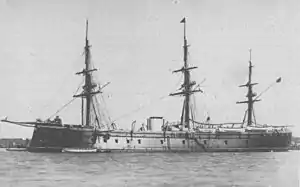Spanish ironclad Numancia
The Spanish ironclad Numancia was an armored frigate bought from France during the 1860s for service with the Royal Spanish Navy (Armada Real). The name was derived from the Siege of Numantia, in which Roman expansion in the Iberian Peninsula was resisted. She was the first ironclad to circumnavigate the Earth. She saw service in the Chincha Islands War and Cantonal Revolution.[1]
 Numancia at anchor | |
| History | |
|---|---|
| Name: | Numancia |
| Namesake: | Siege of Numantia |
| Builder: | Forges et Chantiers de la Méditerranée, La Seyne, France |
| Laid down: | 22 April 1862 |
| Launched: | 19 November 1863 |
| Commissioned: | 17 December 1864 |
| Refit: | 1896–1898 |
| Stricken: | 1912 |
| Fate: | Sank while under tow, 17 December 1916 |
| General characteristics (as built) | |
| Type: | Broadside ironclad |
| Displacement: | 7,305 t (7,190 long tons) |
| Length: | 95.6 m (313 ft 8 in) |
| Beam: | 17.3 m (56 ft 9 in) |
| Draft: | 7.7 m (25 ft) |
| Installed power: | |
| Propulsion: | 1 shaft, 1 horizontal-return connecting-rod steam engines |
| Sail plan: | Ship rig |
| Speed: | 12.7 knots (23.5 km/h; 14.6 mph) |
| Range: | 3,000 nautical miles (5,600 km; 3,500 mi) at 10 knots (19 km/h; 12 mph) |
| Complement: | 561 |
| Armament: | 40 × 68-pounder (203 mm) smoothbore guns |
| Armor: | |
Design and description
.jpg.webp)
Numancia was 95.6 meters (313 ft 8 in) long at the waterline, had a beam of 17.3 meters (56 ft 9 in) and a draft of 7.7 meters (25 ft 3 in).[2] She displaced 7,305 metric tons (7,190 long tons) and was fitted with a ram bow.[3] Her crew consisted of 561 officers and enlisted men.[2]
The ship was fitted with a pair of horizontal-return connecting-rod steam engines from her builder that drove one propeller shaft using steam provided by eight cylindrical boilers.[4] The engines were rated at a total of 1,000 nominal horsepower or 3,700 indicated horsepower (2,800 kW)[3] and gave Numancia a speed of 12.7 knots (23.5 km/h; 14.6 mph)[2] The ironclad carried a maximum of 1,100 metric tons (1,083 long tons) of coal[5] that gave her a range of 3,000 nautical miles (5,600 km; 3,500 mi) at 10 knots (19 km/h; 12 mph).[3] She was fitted with a three-masted ship rig with a sail area of 1,800–1,900 square meters (19,000–20,000 sq ft).[6]
The frigate's main battery initially consisted of forty 200-millimeter (7.9 in) smoothbore guns mounted on the broadside, but her armament was changed around 1867 to with six 229-millimeter (9 in) and three 200 mm Armstrong-Whitworth guns, and eight Trubia 160-millimeter (6.3 in) guns, all of which were rifled muzzle-loading (RML) weapons. The 229 mm and 160 mm guns were situated on the gun deck while the 200 mm guns were positioned on the main deck. In 1883 Numancia was rearmed with eight Armstrong-Whitworth 254-millimeter (10 in) RML guns and seven 200 mm RMLs. When the ship was refitted in France in 1896–1898, her armament was changed to six Hontoria 160 mm and eight Canet 140-millimeter (5.5 in) rifled breech-loading guns and a pair of 354-millimeter (14 in) torpedo tubes.[5][7]
Numancia had a complete wrought iron waterline belt of 130-millimeter (5.1 in) armor plates. Above the belt, the guns were protected by a 120-millimeter (4.7 in) strake of armor that extended the length of the ship. The deck was unarmored.[4]
Construction and career
On 20 October 1873, during the Cantonal Revolution, Numancia collided with and sank the gunboat Fernando el Católico.[8]
In November 1902 she was ordered to Ceuta to protect Spanish citizens in Morocco during unrest in that country.[9]
While being towed to be scrapped in Bilbao she ran aground near Setúbal, Portugal, during a gale on 17 December 1916 en route from Cadiz.[10]
References
| Wikimedia Commons has media related to Numancia (ship, 1863). |
- Pastor y Fernandez de Checa, pp. 3–4
- de Saint Humber, p. 23
- Silverstone, p. 388
- de Saint Hubert, pp. 22–23
- Lyon, p. 380
- de Saint Hubert, pp. 22, 24
- de Saint Hubert, p. 27
- Pastor y Fernandez de Checa, p. 4
- "Latest Intelligence - Morocco". The Times (36927). London. 17 November 1902. p. 1.
- Pastor y Fernandez de Checa, p. 5
Bibliography
- Adamson, Robert E. & de St. Hubert, Christian (1991). "Question 12/89". Warship International. XXVIII (2): 199–205. ISSN 0043-0374.
- Brassey, Thomas (1888). The Naval Annual 1887. Portsmouth, England: J. Griffin. OCLC 669097244.
- de Saint Hubert, Christian (1984). "Early Spanish Steam Warships, Part II". Warship International. XXI (1): 21–45. ISSN 0043-0374.
- Lyon, Hugh (1979). "Spain". In Chesneau, Roger & Kolesnik, Eugene M. (eds.). Conway's All the World's Fighting Ships 1860–1905. Greenwich, UK: Conway Maritime Press. pp. 380–386. ISBN 0-8317-0302-4.
- Pastor y Fernandez de Checa, M. (1976). "The Spanish Ironclads Numancia, Vitoria and Pelayo, Pt. II". F. P. D. S. Newsletter. Akron, Ohio: F. P. D. S. IV (1): 3–5. OCLC 41554533.
- Silverstone, Paul H. (1984). Directory of the World's Capital Ships. New York: Hippocrene Books. ISBN 0-88254-979-0.
- "Spanish Ironclads Numancia and Vitoria". Warship International. VIII (3): 287–289. 1970. ISSN 0043-0374.